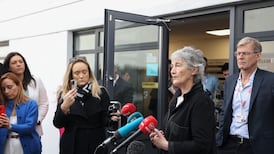I grew up singing Irish rebel songs. One of the first ones I learned, which seared an impression on my young mind, was James Connolly.
In the haunting ballad, Christy Moore laments the 1916 execution of Connolly, the Easter Rising revolutionary, and hero of the working man:
Where oh where is our James Connolly?
Where oh where is that gallant man?
He’s gone to organise the union
That working men they might yet be free.
The child of an immigrant Irish mother living in the US, I grew up immersed in tales of heroic Irishmen. I particularly remember the story of Connolly who, bleeding profusely from his wounds and unable to walk, was carried to the firing range by the British soldiers.
The enduring lure of the Emerald Isle to the millions of Irish who have crossed the Atlantic in search of a better life is well documented, and illustrated in the lyrics of Spancil Hill, another firm favourite from my childhood:
Last night as I lay dreaming of pleasant days gone by
My mind being bent on rambling to Ireland I did fly?
And to Ireland I did indeed fly. When I was five years old we returned, me with a head full of myths, songs, legends and expectations about that homecoming.
Another theme of the songs my mother taught me was women – all of whom seemed to share a defining feature.
In Spancil Hill, the narrator tell us of a flying visit to his first and only love, who's as white as any lily and as gentle as a dove.
In another childhood classic, I'll tell my Ma, the object of everyone's desire is described thus:
All the boys are fighting for her.
They knock at the door and they ring at the bell
Sayin’ “Oh my true love, are you well?”
Out she comes as white as snow?
However, though my mum’s Irish, my father is Nigerian.
I am not white!
This fact, one that I had never even considered before I returned to the land of a thousand welcomes, now became the defining feature of my existence. I remember that first week or so back in Dublin, when I was sent out to play with the local kids. One of the first rhymes I heard was: "Eeny meeeny miny moe. Catch a nigger by da toe." Who, or what in the hell was "nigger", I wondered?
I soon learned.
So began the obsession with my difference that seemed to set the parameters of my life in Ireland. The “black one”, the “dark one” were the politer epithets; but polite or not (usually not), it was constant.
My race seemed to be the first port of call in everybody’s perception of me. Growing up in Ireland was characterised by overt racism, covert racism, isolation, bullying and stigmatisation.
Specifically, many of the problems arose out of my claims of Irishness itself.
That was what really seemed to offend people’s sensibilities. Irishness is synonymous with whiteness, it seemed. Whiteness is “pure” and doesn’t extend to brown girls, even those who can trace their Irish ancestry back to the 10th century. How frequently I heard that I “wasn’t really Irish”.
But I am Irish.
In addition to being born there, my mother, her parents before her, and theirs before them, for generations and generations, are all Irish.
I carry the songs of my childhood within me still, I always will. I am teaching them to my son, and he loves them as much as I did. This music is part of me; the sentiments, the revolutionary fervour it instilled in me from my earliest memories, imbue all of my work and activism. Yet, there is little space for me in Ireland to live or fit comfortably within the borders of my homeland.
Did those revolutionary men and women who fought so bravely to liberate the land of my birth, who captured my imagination from such a young age, fight for my liberation too?
I believe that the Ireland envisaged by men like Connolly, the revolutionary socialist, or Roger Casement, another Irish nationalist and humanitarian activist also executed in 1916, was not the one that greeted me when I returned home all those years ago.
Reflecting on all of this often conjures to my mind the words of WB Yeats, in his infamous poem, September 1913.
Although he is speaking of an earlier period in Ireland’s revolutionary history (we were fighting the English for a long time) his words are eerily prescient:
Was it for this the wild geese spread
The grey wing upon every tide;
For this that all that blood was shed,
For this Edward Fitzgerald died,
And Robert Emmet and Wolfe Tone,
All that delirium of the brave?
Romantic Ireland’s dead and gone,
It’s with O’Leary in the grave.
– (Guardian Service)










